CISP400V9 Assignment 5: Complex & Bank Accounts
VerifiedAdded on 2019/10/09
|11
|3830
|198
Homework Assignment
AI Summary
This assignment for CISP400V9 involves two parts: A5 and AD5. A5 requires modifying a Complex class to overload operators for input, output, multiplication, division, comparison, and assignment, along with creating a test driver. AD5 involves creating an inheritance hierarchy for bank accounts, including Account, SavingsAccount, and CheckingAccount classes, with specific functionalities like interest calculation and transaction fees. Both parts require proper documentation and submission in a zip file. The assignment also provides sample executable files and starter code for reference.
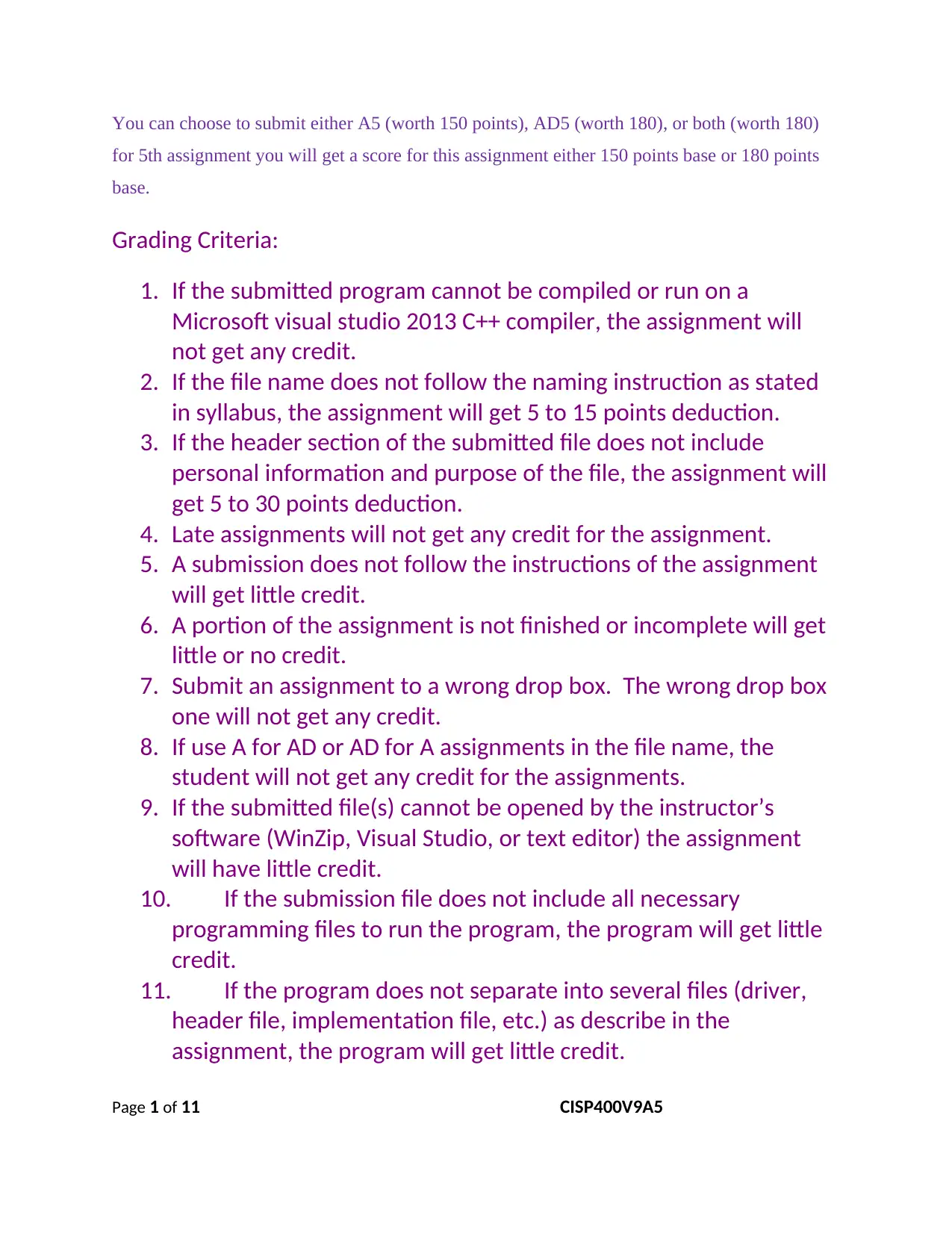
You can choose to submit either A5 (worth 150 points), AD5 (worth 180), or both (worth 180)
for 5th assignment you will get a score for this assignment either 150 points base or 180 points
base.
Grading Criteria:
1. If the submitted program cannot be compiled or run on a
Microsoft visual studio 2013 C++ compiler, the assignment will
not get any credit.
2. If the file name does not follow the naming instruction as stated
in syllabus, the assignment will get 5 to 15 points deduction.
3. If the header section of the submitted file does not include
personal information and purpose of the file, the assignment will
get 5 to 30 points deduction.
4. Late assignments will not get any credit for the assignment.
5. A submission does not follow the instructions of the assignment
will get little credit.
6. A portion of the assignment is not finished or incomplete will get
little or no credit.
7. Submit an assignment to a wrong drop box. The wrong drop box
one will not get any credit.
8. If use A for AD or AD for A assignments in the file name, the
student will not get any credit for the assignments.
9. If the submitted file(s) cannot be opened by the instructor’s
software (WinZip, Visual Studio, or text editor) the assignment
will have little credit.
10. If the submission file does not include all necessary
programming files to run the program, the program will get little
credit.
11. If the program does not separate into several files (driver,
header file, implementation file, etc.) as describe in the
assignment, the program will get little credit.
Page 1 of 11 CISP400V9A5
for 5th assignment you will get a score for this assignment either 150 points base or 180 points
base.
Grading Criteria:
1. If the submitted program cannot be compiled or run on a
Microsoft visual studio 2013 C++ compiler, the assignment will
not get any credit.
2. If the file name does not follow the naming instruction as stated
in syllabus, the assignment will get 5 to 15 points deduction.
3. If the header section of the submitted file does not include
personal information and purpose of the file, the assignment will
get 5 to 30 points deduction.
4. Late assignments will not get any credit for the assignment.
5. A submission does not follow the instructions of the assignment
will get little credit.
6. A portion of the assignment is not finished or incomplete will get
little or no credit.
7. Submit an assignment to a wrong drop box. The wrong drop box
one will not get any credit.
8. If use A for AD or AD for A assignments in the file name, the
student will not get any credit for the assignments.
9. If the submitted file(s) cannot be opened by the instructor’s
software (WinZip, Visual Studio, or text editor) the assignment
will have little credit.
10. If the submission file does not include all necessary
programming files to run the program, the program will get little
credit.
11. If the program does not separate into several files (driver,
header file, implementation file, etc.) as describe in the
assignment, the program will get little credit.
Page 1 of 11 CISP400V9A5
Paraphrase This Document
Need a fresh take? Get an instant paraphrase of this document with our AI Paraphraser
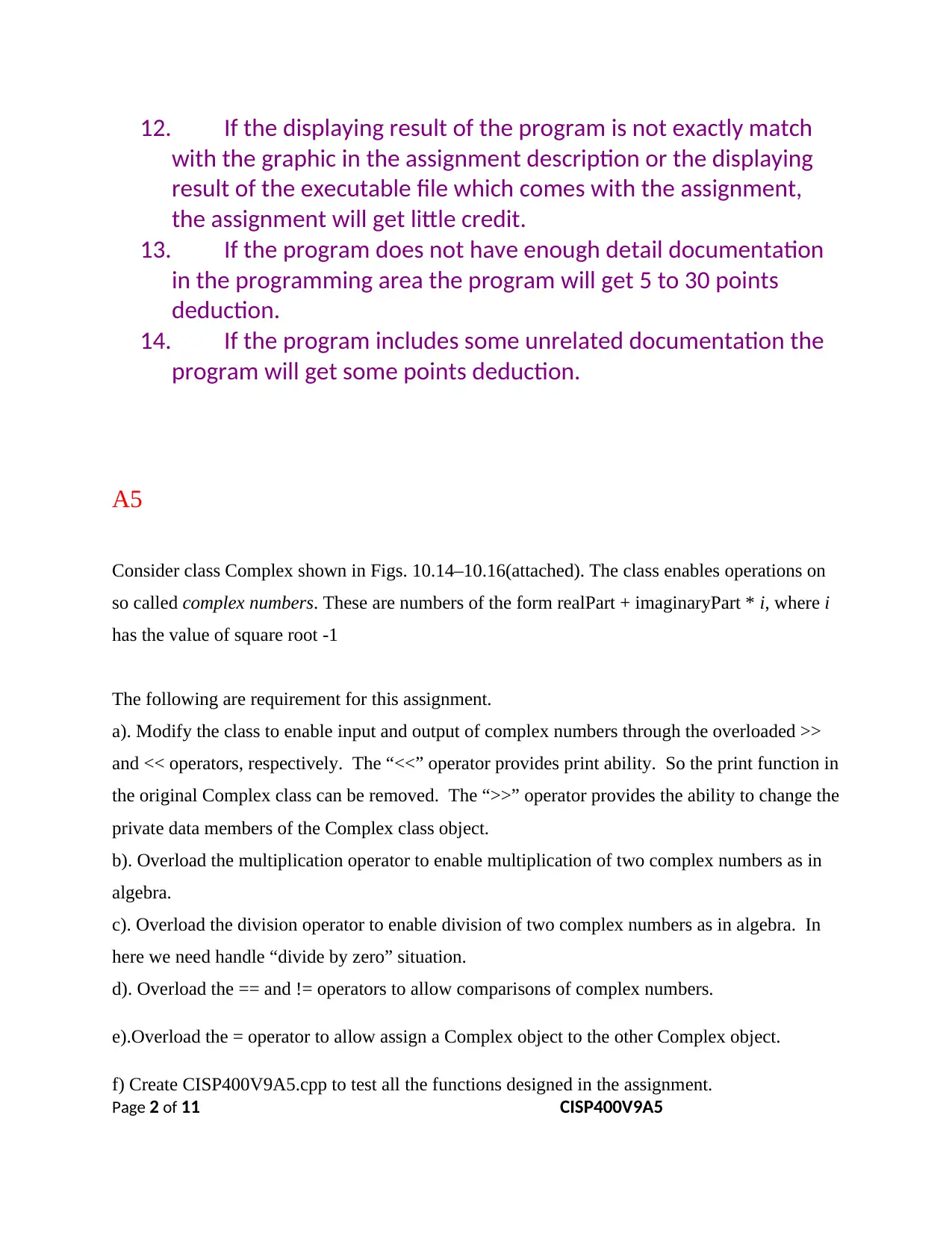
12. If the displaying result of the program is not exactly match
with the graphic in the assignment description or the displaying
result of the executable file which comes with the assignment,
the assignment will get little credit.
13. If the program does not have enough detail documentation
in the programming area the program will get 5 to 30 points
deduction.
14. If the program includes some unrelated documentation the
program will get some points deduction.
A5
Consider class Complex shown in Figs. 10.14–10.16(attached). The class enables operations on
so called complex numbers. These are numbers of the form realPart + imaginaryPart * i, where i
has the value of square root -1
The following are requirement for this assignment.
a). Modify the class to enable input and output of complex numbers through the overloaded >>
and << operators, respectively. The “<<” operator provides print ability. So the print function in
the original Complex class can be removed. The “>>” operator provides the ability to change the
private data members of the Complex class object.
b). Overload the multiplication operator to enable multiplication of two complex numbers as in
algebra.
c). Overload the division operator to enable division of two complex numbers as in algebra. In
here we need handle “divide by zero” situation.
d). Overload the == and != operators to allow comparisons of complex numbers.
e).Overload the = operator to allow assign a Complex object to the other Complex object.
f) Create CISP400V9A5.cpp to test all the functions designed in the assignment.
Page 2 of 11 CISP400V9A5
with the graphic in the assignment description or the displaying
result of the executable file which comes with the assignment,
the assignment will get little credit.
13. If the program does not have enough detail documentation
in the programming area the program will get 5 to 30 points
deduction.
14. If the program includes some unrelated documentation the
program will get some points deduction.
A5
Consider class Complex shown in Figs. 10.14–10.16(attached). The class enables operations on
so called complex numbers. These are numbers of the form realPart + imaginaryPart * i, where i
has the value of square root -1
The following are requirement for this assignment.
a). Modify the class to enable input and output of complex numbers through the overloaded >>
and << operators, respectively. The “<<” operator provides print ability. So the print function in
the original Complex class can be removed. The “>>” operator provides the ability to change the
private data members of the Complex class object.
b). Overload the multiplication operator to enable multiplication of two complex numbers as in
algebra.
c). Overload the division operator to enable division of two complex numbers as in algebra. In
here we need handle “divide by zero” situation.
d). Overload the == and != operators to allow comparisons of complex numbers.
e).Overload the = operator to allow assign a Complex object to the other Complex object.
f) Create CISP400V9A5.cpp to test all the functions designed in the assignment.
Page 2 of 11 CISP400V9A5
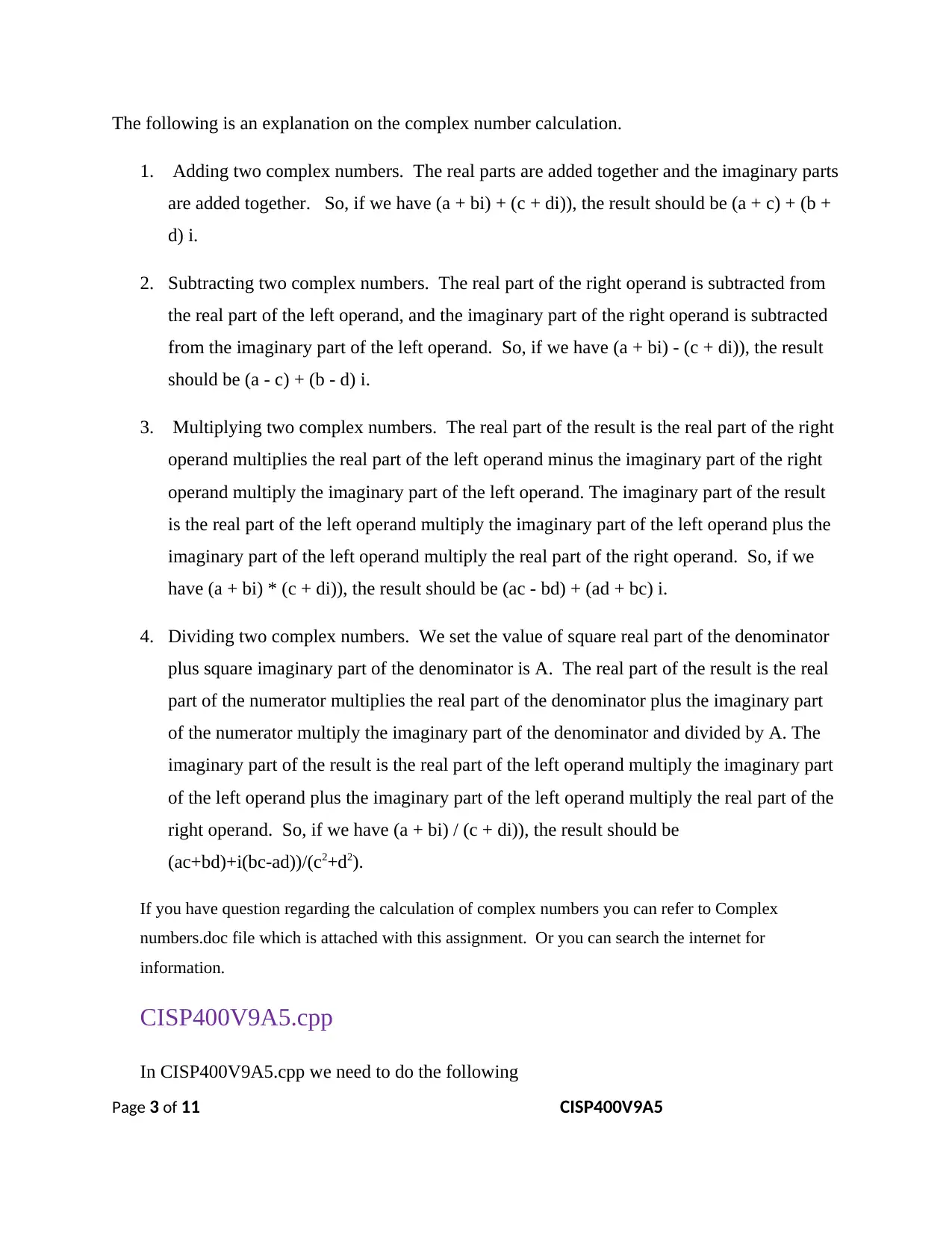
The following is an explanation on the complex number calculation.
1. Adding two complex numbers. The real parts are added together and the imaginary parts
are added together. So, if we have (a + bi) + (c + di)), the result should be (a + c) + (b +
d) i.
2. Subtracting two complex numbers. The real part of the right operand is subtracted from
the real part of the left operand, and the imaginary part of the right operand is subtracted
from the imaginary part of the left operand. So, if we have (a + bi) - (c + di)), the result
should be (a - c) + (b - d) i.
3. Multiplying two complex numbers. The real part of the result is the real part of the right
operand multiplies the real part of the left operand minus the imaginary part of the right
operand multiply the imaginary part of the left operand. The imaginary part of the result
is the real part of the left operand multiply the imaginary part of the left operand plus the
imaginary part of the left operand multiply the real part of the right operand. So, if we
have (a + bi) * (c + di)), the result should be (ac - bd) + (ad + bc) i.
4. Dividing two complex numbers. We set the value of square real part of the denominator
plus square imaginary part of the denominator is A. The real part of the result is the real
part of the numerator multiplies the real part of the denominator plus the imaginary part
of the numerator multiply the imaginary part of the denominator and divided by A. The
imaginary part of the result is the real part of the left operand multiply the imaginary part
of the left operand plus the imaginary part of the left operand multiply the real part of the
right operand. So, if we have (a + bi) / (c + di)), the result should be
(ac+bd)+i(bc-ad))/(c2+d2).
If you have question regarding the calculation of complex numbers you can refer to Complex
numbers.doc file which is attached with this assignment. Or you can search the internet for
information.
CISP400V9A5.cpp
In CISP400V9A5.cpp we need to do the following
Page 3 of 11 CISP400V9A5
1. Adding two complex numbers. The real parts are added together and the imaginary parts
are added together. So, if we have (a + bi) + (c + di)), the result should be (a + c) + (b +
d) i.
2. Subtracting two complex numbers. The real part of the right operand is subtracted from
the real part of the left operand, and the imaginary part of the right operand is subtracted
from the imaginary part of the left operand. So, if we have (a + bi) - (c + di)), the result
should be (a - c) + (b - d) i.
3. Multiplying two complex numbers. The real part of the result is the real part of the right
operand multiplies the real part of the left operand minus the imaginary part of the right
operand multiply the imaginary part of the left operand. The imaginary part of the result
is the real part of the left operand multiply the imaginary part of the left operand plus the
imaginary part of the left operand multiply the real part of the right operand. So, if we
have (a + bi) * (c + di)), the result should be (ac - bd) + (ad + bc) i.
4. Dividing two complex numbers. We set the value of square real part of the denominator
plus square imaginary part of the denominator is A. The real part of the result is the real
part of the numerator multiplies the real part of the denominator plus the imaginary part
of the numerator multiply the imaginary part of the denominator and divided by A. The
imaginary part of the result is the real part of the left operand multiply the imaginary part
of the left operand plus the imaginary part of the left operand multiply the real part of the
right operand. So, if we have (a + bi) / (c + di)), the result should be
(ac+bd)+i(bc-ad))/(c2+d2).
If you have question regarding the calculation of complex numbers you can refer to Complex
numbers.doc file which is attached with this assignment. Or you can search the internet for
information.
CISP400V9A5.cpp
In CISP400V9A5.cpp we need to do the following
Page 3 of 11 CISP400V9A5
⊘ This is a preview!⊘
Do you want full access?
Subscribe today to unlock all pages.

Trusted by 1+ million students worldwide
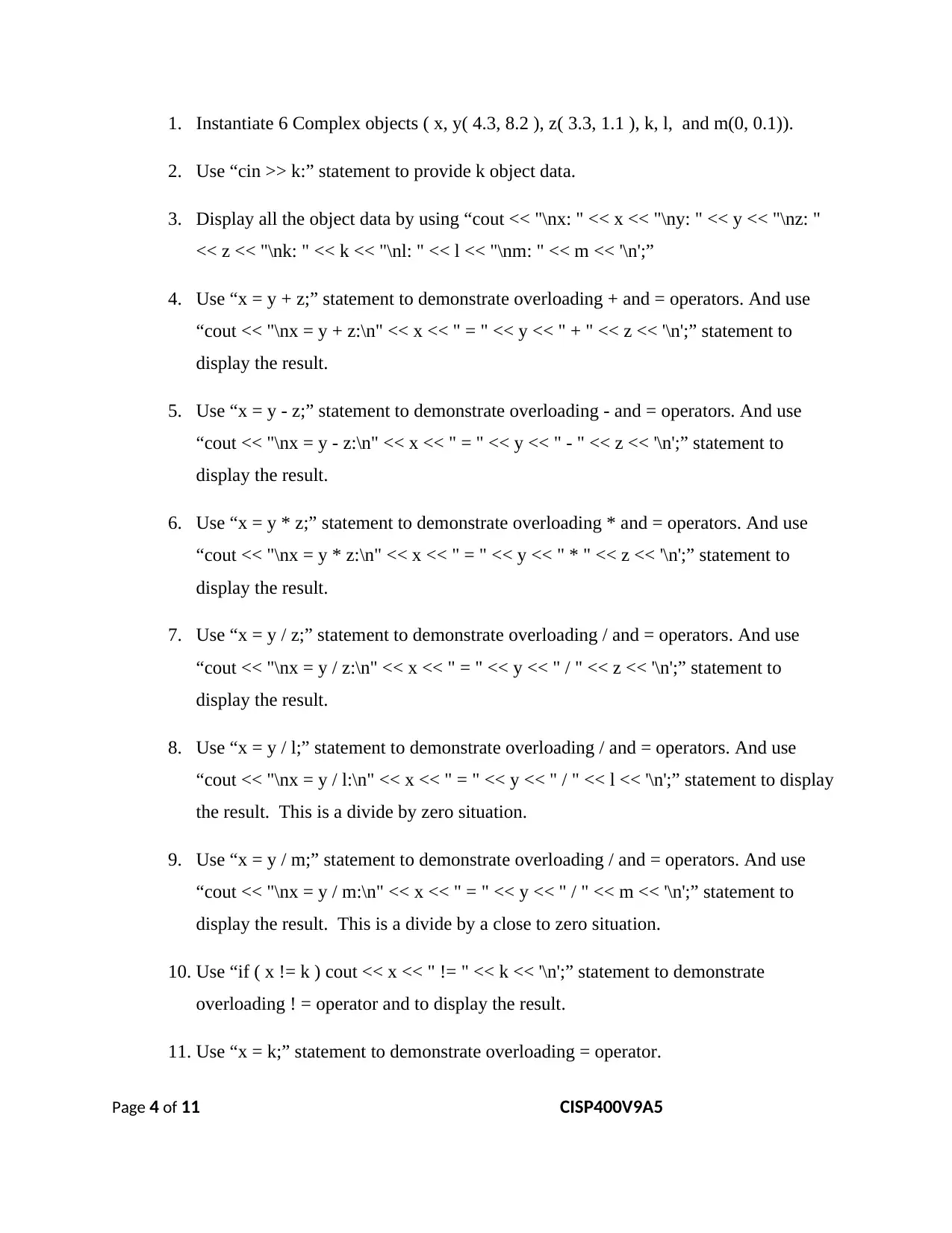
1. Instantiate 6 Complex objects ( x, y( 4.3, 8.2 ), z( 3.3, 1.1 ), k, l, and m(0, 0.1)).
2. Use “cin >> k:” statement to provide k object data.
3. Display all the object data by using “cout << "\nx: " << x << "\ny: " << y << "\nz: "
<< z << "\nk: " << k << "\nl: " << l << "\nm: " << m << '\n';”
4. Use “x = y + z;” statement to demonstrate overloading + and = operators. And use
“cout << "\nx = y + z:\n" << x << " = " << y << " + " << z << '\n';” statement to
display the result.
5. Use “x = y - z;” statement to demonstrate overloading - and = operators. And use
“cout << "\nx = y - z:\n" << x << " = " << y << " - " << z << '\n';” statement to
display the result.
6. Use “x = y * z;” statement to demonstrate overloading * and = operators. And use
“cout << "\nx = y * z:\n" << x << " = " << y << " * " << z << '\n';” statement to
display the result.
7. Use “x = y / z;” statement to demonstrate overloading / and = operators. And use
“cout << "\nx = y / z:\n" << x << " = " << y << " / " << z << '\n';” statement to
display the result.
8. Use “x = y / l;” statement to demonstrate overloading / and = operators. And use
“cout << "\nx = y / l:\n" << x << " = " << y << " / " << l << '\n';” statement to display
the result. This is a divide by zero situation.
9. Use “x = y / m;” statement to demonstrate overloading / and = operators. And use
“cout << "\nx = y / m:\n" << x << " = " << y << " / " << m << '\n';” statement to
display the result. This is a divide by a close to zero situation.
10. Use “if ( x != k ) cout << x << " != " << k << '\n';” statement to demonstrate
overloading ! = operator and to display the result.
11. Use “x = k;” statement to demonstrate overloading = operator.
Page 4 of 11 CISP400V9A5
2. Use “cin >> k:” statement to provide k object data.
3. Display all the object data by using “cout << "\nx: " << x << "\ny: " << y << "\nz: "
<< z << "\nk: " << k << "\nl: " << l << "\nm: " << m << '\n';”
4. Use “x = y + z;” statement to demonstrate overloading + and = operators. And use
“cout << "\nx = y + z:\n" << x << " = " << y << " + " << z << '\n';” statement to
display the result.
5. Use “x = y - z;” statement to demonstrate overloading - and = operators. And use
“cout << "\nx = y - z:\n" << x << " = " << y << " - " << z << '\n';” statement to
display the result.
6. Use “x = y * z;” statement to demonstrate overloading * and = operators. And use
“cout << "\nx = y * z:\n" << x << " = " << y << " * " << z << '\n';” statement to
display the result.
7. Use “x = y / z;” statement to demonstrate overloading / and = operators. And use
“cout << "\nx = y / z:\n" << x << " = " << y << " / " << z << '\n';” statement to
display the result.
8. Use “x = y / l;” statement to demonstrate overloading / and = operators. And use
“cout << "\nx = y / l:\n" << x << " = " << y << " / " << l << '\n';” statement to display
the result. This is a divide by zero situation.
9. Use “x = y / m;” statement to demonstrate overloading / and = operators. And use
“cout << "\nx = y / m:\n" << x << " = " << y << " / " << m << '\n';” statement to
display the result. This is a divide by a close to zero situation.
10. Use “if ( x != k ) cout << x << " != " << k << '\n';” statement to demonstrate
overloading ! = operator and to display the result.
11. Use “x = k;” statement to demonstrate overloading = operator.
Page 4 of 11 CISP400V9A5
Paraphrase This Document
Need a fresh take? Get an instant paraphrase of this document with our AI Paraphraser
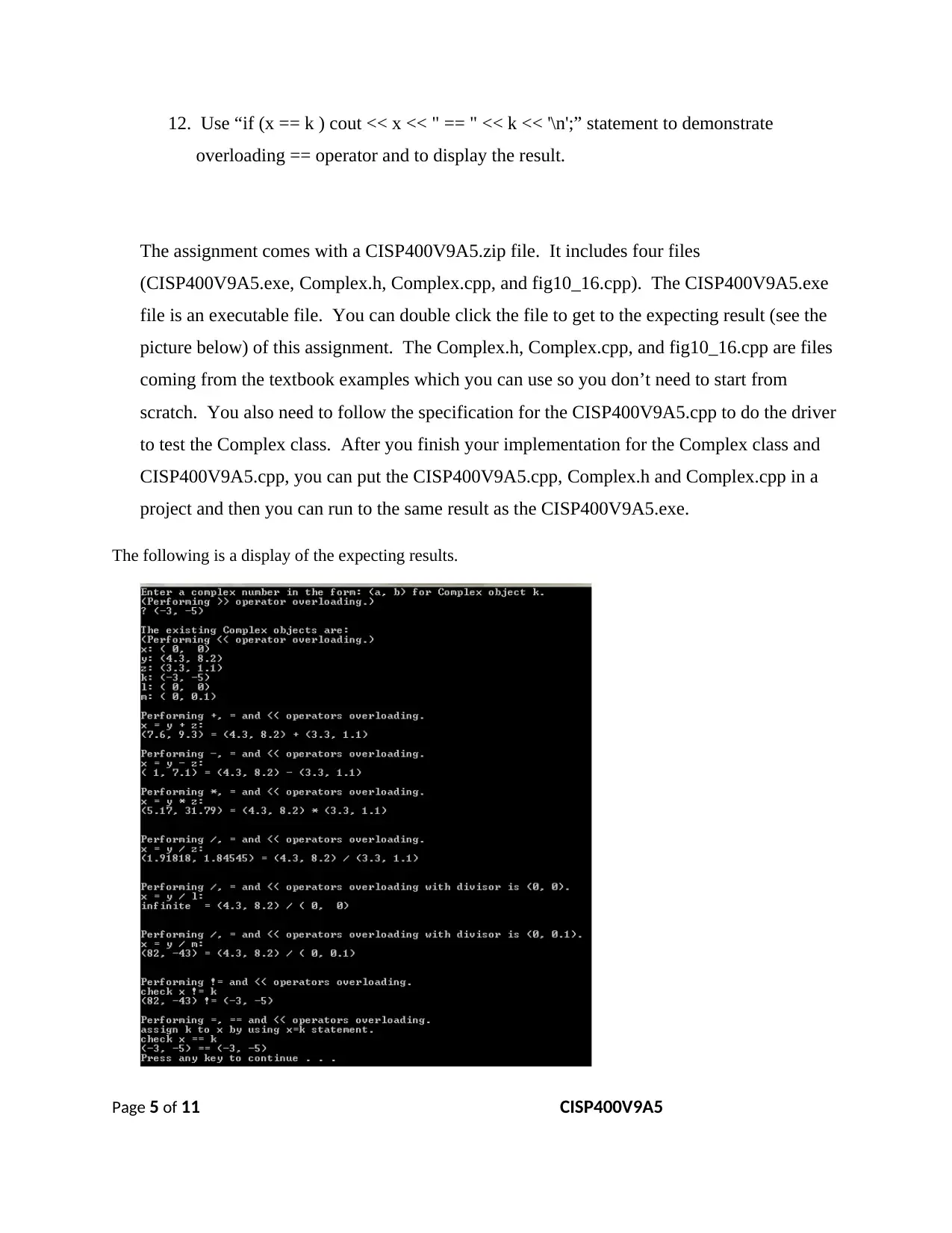
12. Use “if (x == k ) cout << x << " == " << k << '\n';” statement to demonstrate
overloading == operator and to display the result.
The assignment comes with a CISP400V9A5.zip file. It includes four files
(CISP400V9A5.exe, Complex.h, Complex.cpp, and fig10_16.cpp). The CISP400V9A5.exe
file is an executable file. You can double click the file to get to the expecting result (see the
picture below) of this assignment. The Complex.h, Complex.cpp, and fig10_16.cpp are files
coming from the textbook examples which you can use so you don’t need to start from
scratch. You also need to follow the specification for the CISP400V9A5.cpp to do the driver
to test the Complex class. After you finish your implementation for the Complex class and
CISP400V9A5.cpp, you can put the CISP400V9A5.cpp, Complex.h and Complex.cpp in a
project and then you can run to the same result as the CISP400V9A5.exe.
The following is a display of the expecting results.
Page 5 of 11 CISP400V9A5
overloading == operator and to display the result.
The assignment comes with a CISP400V9A5.zip file. It includes four files
(CISP400V9A5.exe, Complex.h, Complex.cpp, and fig10_16.cpp). The CISP400V9A5.exe
file is an executable file. You can double click the file to get to the expecting result (see the
picture below) of this assignment. The Complex.h, Complex.cpp, and fig10_16.cpp are files
coming from the textbook examples which you can use so you don’t need to start from
scratch. You also need to follow the specification for the CISP400V9A5.cpp to do the driver
to test the Complex class. After you finish your implementation for the Complex class and
CISP400V9A5.cpp, you can put the CISP400V9A5.cpp, Complex.h and Complex.cpp in a
project and then you can run to the same result as the CISP400V9A5.exe.
The following is a display of the expecting results.
Page 5 of 11 CISP400V9A5
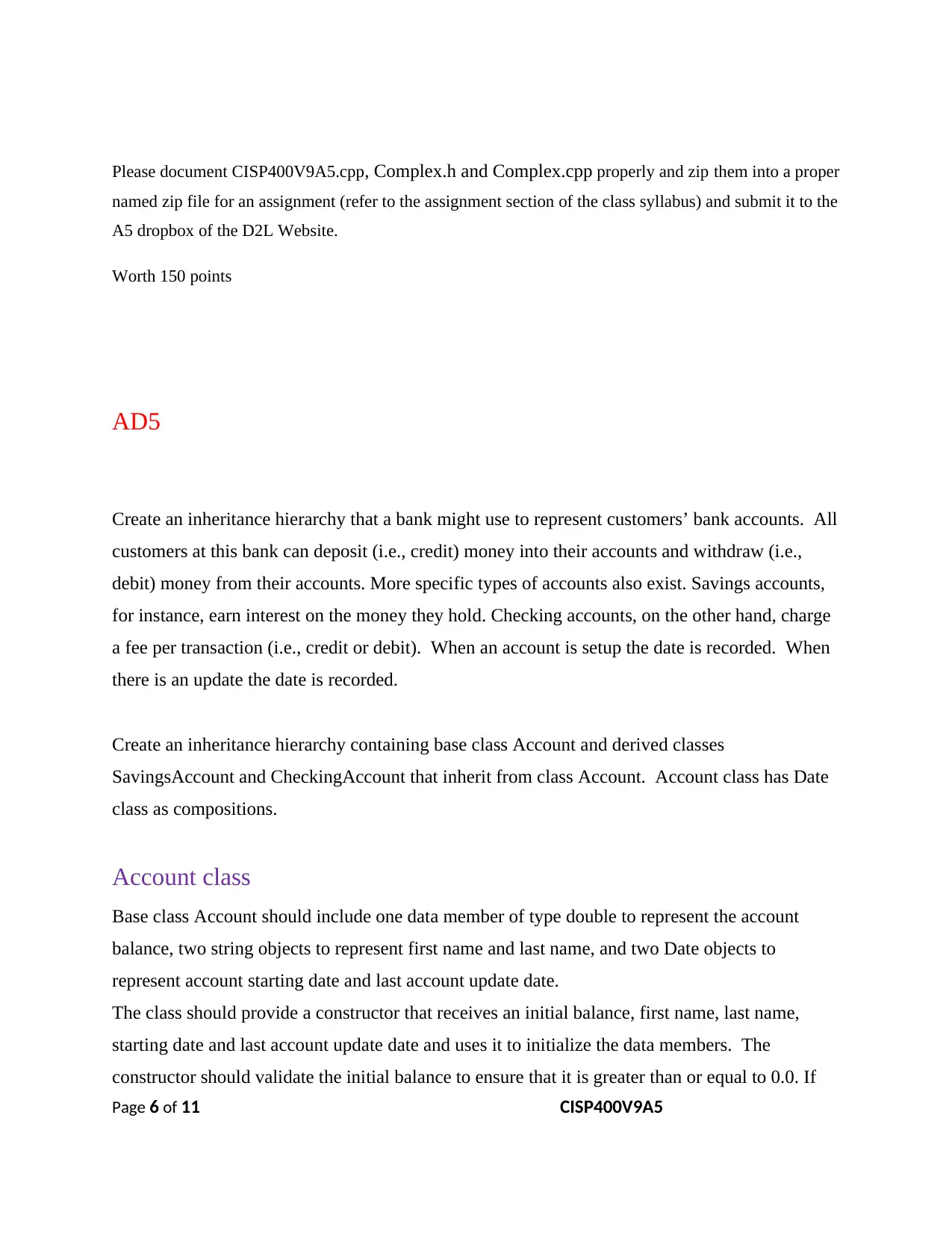
Please document CISP400V9A5.cpp, Complex.h and Complex.cpp properly and zip them into a proper
named zip file for an assignment (refer to the assignment section of the class syllabus) and submit it to the
A5 dropbox of the D2L Website.
Worth 150 points
AD5
Create an inheritance hierarchy that a bank might use to represent customers’ bank accounts. All
customers at this bank can deposit (i.e., credit) money into their accounts and withdraw (i.e.,
debit) money from their accounts. More specific types of accounts also exist. Savings accounts,
for instance, earn interest on the money they hold. Checking accounts, on the other hand, charge
a fee per transaction (i.e., credit or debit). When an account is setup the date is recorded. When
there is an update the date is recorded.
Create an inheritance hierarchy containing base class Account and derived classes
SavingsAccount and CheckingAccount that inherit from class Account. Account class has Date
class as compositions.
Account class
Base class Account should include one data member of type double to represent the account
balance, two string objects to represent first name and last name, and two Date objects to
represent account starting date and last account update date.
The class should provide a constructor that receives an initial balance, first name, last name,
starting date and last account update date and uses it to initialize the data members. The
constructor should validate the initial balance to ensure that it is greater than or equal to 0.0. If
Page 6 of 11 CISP400V9A5
named zip file for an assignment (refer to the assignment section of the class syllabus) and submit it to the
A5 dropbox of the D2L Website.
Worth 150 points
AD5
Create an inheritance hierarchy that a bank might use to represent customers’ bank accounts. All
customers at this bank can deposit (i.e., credit) money into their accounts and withdraw (i.e.,
debit) money from their accounts. More specific types of accounts also exist. Savings accounts,
for instance, earn interest on the money they hold. Checking accounts, on the other hand, charge
a fee per transaction (i.e., credit or debit). When an account is setup the date is recorded. When
there is an update the date is recorded.
Create an inheritance hierarchy containing base class Account and derived classes
SavingsAccount and CheckingAccount that inherit from class Account. Account class has Date
class as compositions.
Account class
Base class Account should include one data member of type double to represent the account
balance, two string objects to represent first name and last name, and two Date objects to
represent account starting date and last account update date.
The class should provide a constructor that receives an initial balance, first name, last name,
starting date and last account update date and uses it to initialize the data members. The
constructor should validate the initial balance to ensure that it is greater than or equal to 0.0. If
Page 6 of 11 CISP400V9A5
⊘ This is a preview!⊘
Do you want full access?
Subscribe today to unlock all pages.

Trusted by 1+ million students worldwide
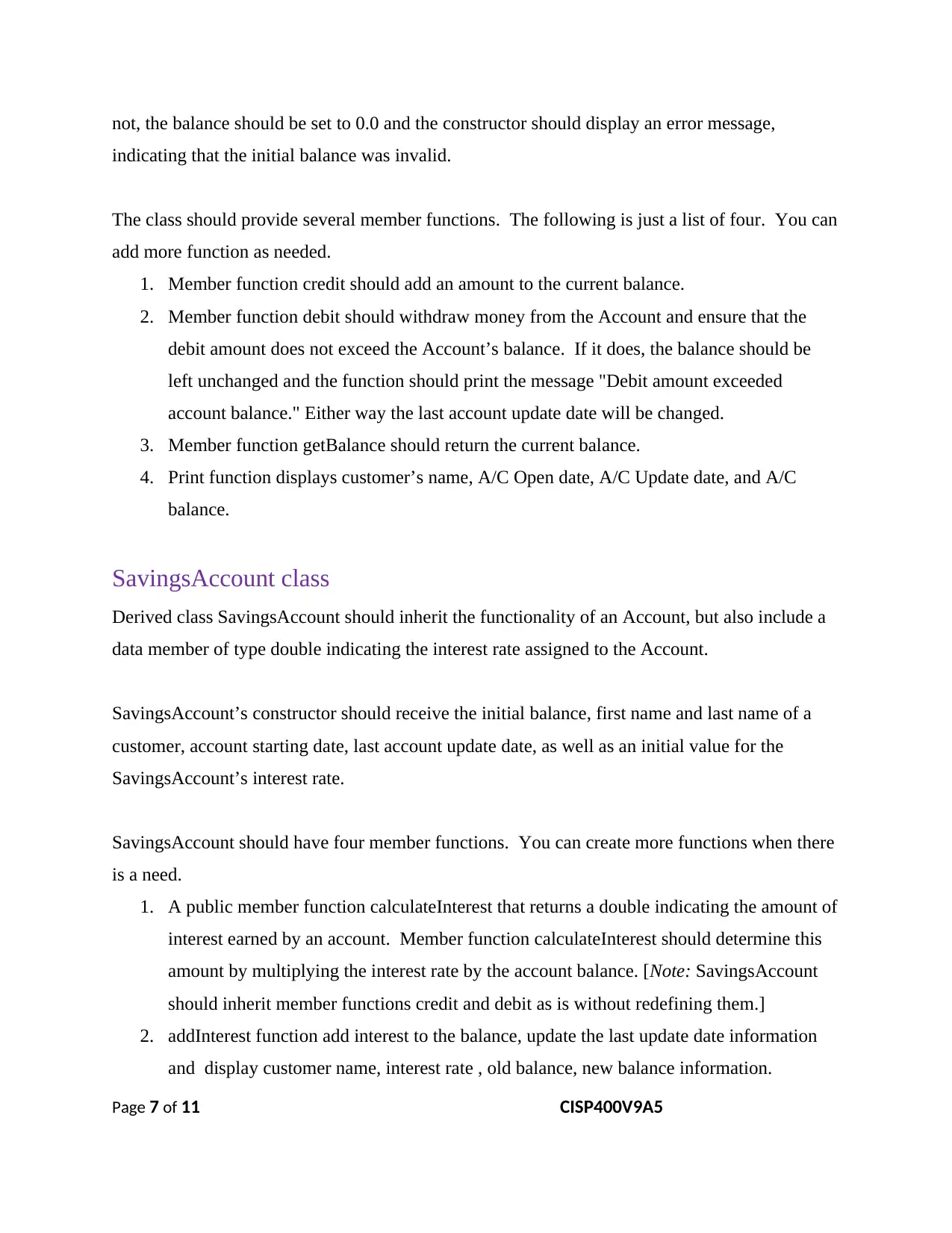
not, the balance should be set to 0.0 and the constructor should display an error message,
indicating that the initial balance was invalid.
The class should provide several member functions. The following is just a list of four. You can
add more function as needed.
1. Member function credit should add an amount to the current balance.
2. Member function debit should withdraw money from the Account and ensure that the
debit amount does not exceed the Account’s balance. If it does, the balance should be
left unchanged and the function should print the message "Debit amount exceeded
account balance." Either way the last account update date will be changed.
3. Member function getBalance should return the current balance.
4. Print function displays customer’s name, A/C Open date, A/C Update date, and A/C
balance.
SavingsAccount class
Derived class SavingsAccount should inherit the functionality of an Account, but also include a
data member of type double indicating the interest rate assigned to the Account.
SavingsAccount’s constructor should receive the initial balance, first name and last name of a
customer, account starting date, last account update date, as well as an initial value for the
SavingsAccount’s interest rate.
SavingsAccount should have four member functions. You can create more functions when there
is a need.
1. A public member function calculateInterest that returns a double indicating the amount of
interest earned by an account. Member function calculateInterest should determine this
amount by multiplying the interest rate by the account balance. [Note: SavingsAccount
should inherit member functions credit and debit as is without redefining them.]
2. addInterest function add interest to the balance, update the last update date information
and display customer name, interest rate , old balance, new balance information.
Page 7 of 11 CISP400V9A5
indicating that the initial balance was invalid.
The class should provide several member functions. The following is just a list of four. You can
add more function as needed.
1. Member function credit should add an amount to the current balance.
2. Member function debit should withdraw money from the Account and ensure that the
debit amount does not exceed the Account’s balance. If it does, the balance should be
left unchanged and the function should print the message "Debit amount exceeded
account balance." Either way the last account update date will be changed.
3. Member function getBalance should return the current balance.
4. Print function displays customer’s name, A/C Open date, A/C Update date, and A/C
balance.
SavingsAccount class
Derived class SavingsAccount should inherit the functionality of an Account, but also include a
data member of type double indicating the interest rate assigned to the Account.
SavingsAccount’s constructor should receive the initial balance, first name and last name of a
customer, account starting date, last account update date, as well as an initial value for the
SavingsAccount’s interest rate.
SavingsAccount should have four member functions. You can create more functions when there
is a need.
1. A public member function calculateInterest that returns a double indicating the amount of
interest earned by an account. Member function calculateInterest should determine this
amount by multiplying the interest rate by the account balance. [Note: SavingsAccount
should inherit member functions credit and debit as is without redefining them.]
2. addInterest function add interest to the balance, update the last update date information
and display customer name, interest rate , old balance, new balance information.
Page 7 of 11 CISP400V9A5
Paraphrase This Document
Need a fresh take? Get an instant paraphrase of this document with our AI Paraphraser
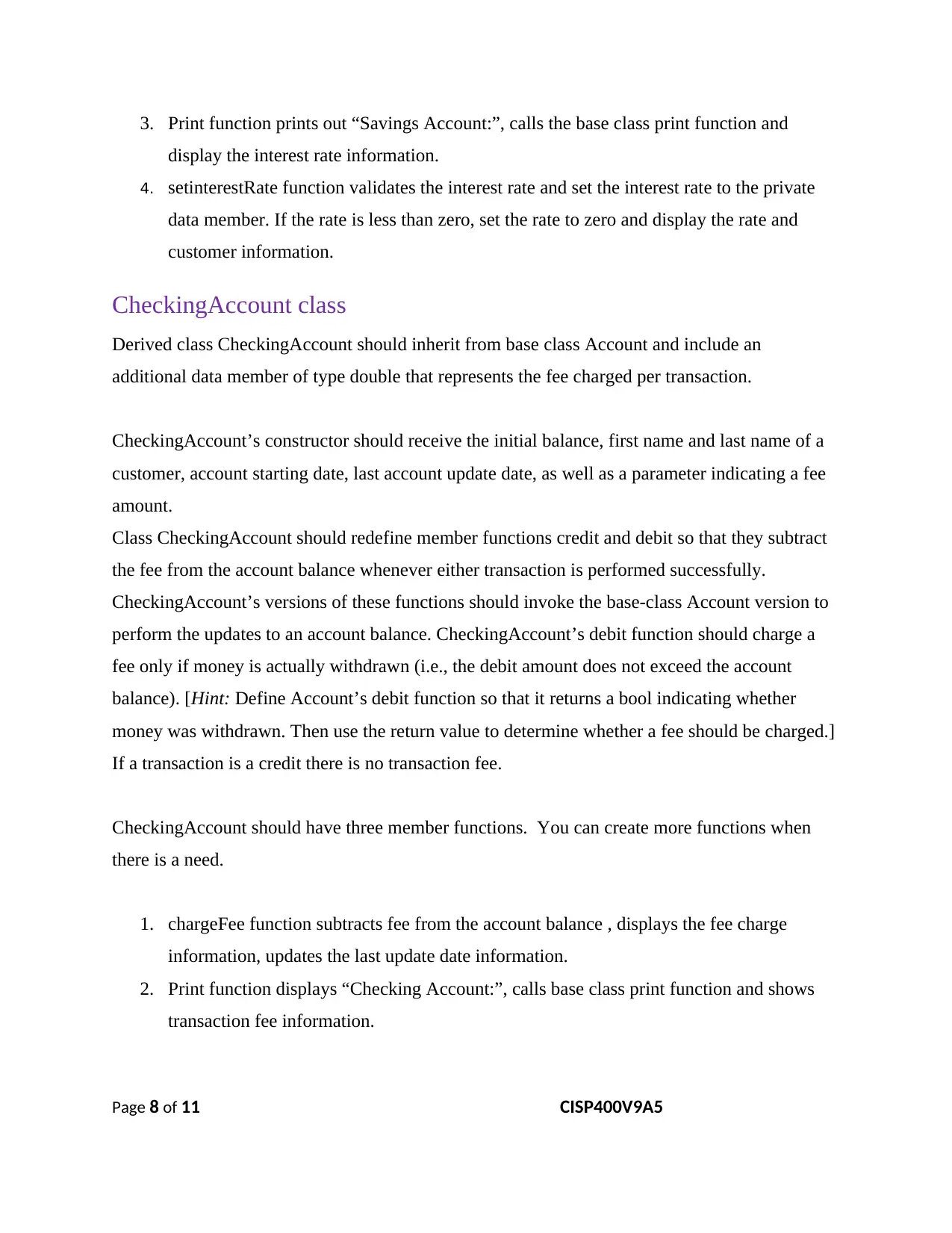
3. Print function prints out “Savings Account:”, calls the base class print function and
display the interest rate information.
4. setinterestRate function validates the interest rate and set the interest rate to the private
data member. If the rate is less than zero, set the rate to zero and display the rate and
customer information.
CheckingAccount class
Derived class CheckingAccount should inherit from base class Account and include an
additional data member of type double that represents the fee charged per transaction.
CheckingAccount’s constructor should receive the initial balance, first name and last name of a
customer, account starting date, last account update date, as well as a parameter indicating a fee
amount.
Class CheckingAccount should redefine member functions credit and debit so that they subtract
the fee from the account balance whenever either transaction is performed successfully.
CheckingAccount’s versions of these functions should invoke the base-class Account version to
perform the updates to an account balance. CheckingAccount’s debit function should charge a
fee only if money is actually withdrawn (i.e., the debit amount does not exceed the account
balance). [Hint: Define Account’s debit function so that it returns a bool indicating whether
money was withdrawn. Then use the return value to determine whether a fee should be charged.]
If a transaction is a credit there is no transaction fee.
CheckingAccount should have three member functions. You can create more functions when
there is a need.
1. chargeFee function subtracts fee from the account balance , displays the fee charge
information, updates the last update date information.
2. Print function displays “Checking Account:”, calls base class print function and shows
transaction fee information.
Page 8 of 11 CISP400V9A5
display the interest rate information.
4. setinterestRate function validates the interest rate and set the interest rate to the private
data member. If the rate is less than zero, set the rate to zero and display the rate and
customer information.
CheckingAccount class
Derived class CheckingAccount should inherit from base class Account and include an
additional data member of type double that represents the fee charged per transaction.
CheckingAccount’s constructor should receive the initial balance, first name and last name of a
customer, account starting date, last account update date, as well as a parameter indicating a fee
amount.
Class CheckingAccount should redefine member functions credit and debit so that they subtract
the fee from the account balance whenever either transaction is performed successfully.
CheckingAccount’s versions of these functions should invoke the base-class Account version to
perform the updates to an account balance. CheckingAccount’s debit function should charge a
fee only if money is actually withdrawn (i.e., the debit amount does not exceed the account
balance). [Hint: Define Account’s debit function so that it returns a bool indicating whether
money was withdrawn. Then use the return value to determine whether a fee should be charged.]
If a transaction is a credit there is no transaction fee.
CheckingAccount should have three member functions. You can create more functions when
there is a need.
1. chargeFee function subtracts fee from the account balance , displays the fee charge
information, updates the last update date information.
2. Print function displays “Checking Account:”, calls base class print function and shows
transaction fee information.
Page 8 of 11 CISP400V9A5
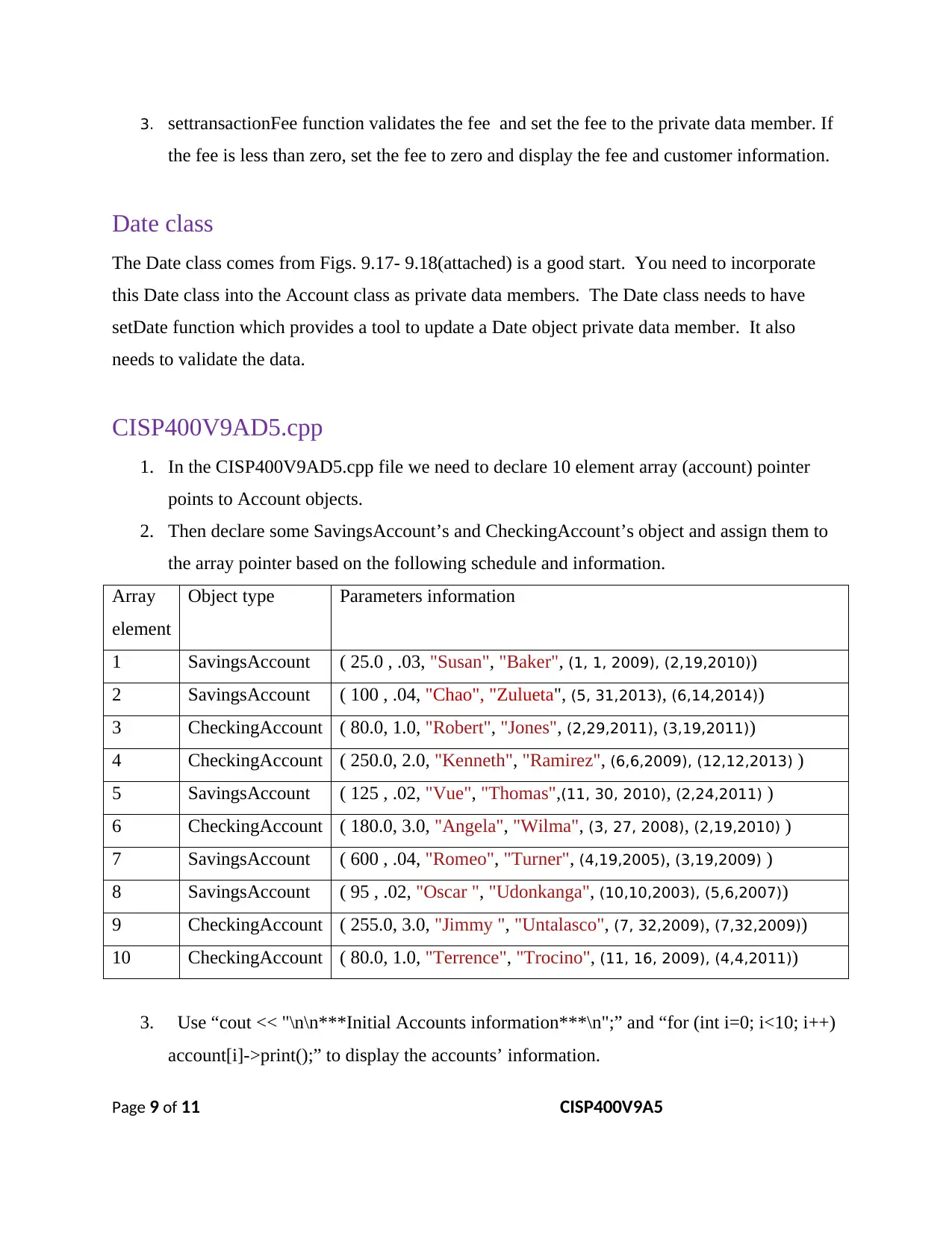
3. settransactionFee function validates the fee and set the fee to the private data member. If
the fee is less than zero, set the fee to zero and display the fee and customer information.
Date class
The Date class comes from Figs. 9.17- 9.18(attached) is a good start. You need to incorporate
this Date class into the Account class as private data members. The Date class needs to have
setDate function which provides a tool to update a Date object private data member. It also
needs to validate the data.
CISP400V9AD5.cpp
1. In the CISP400V9AD5.cpp file we need to declare 10 element array (account) pointer
points to Account objects.
2. Then declare some SavingsAccount’s and CheckingAccount’s object and assign them to
the array pointer based on the following schedule and information.
Array
element
Object type Parameters information
1 SavingsAccount ( 25.0 , .03, "Susan", "Baker", (1, 1, 2009), (2,19,2010))
2 SavingsAccount ( 100 , .04, "Chao", "Zulueta", (5, 31,2013), (6,14,2014))
3 CheckingAccount ( 80.0, 1.0, "Robert", "Jones", (2,29,2011), (3,19,2011))
4 CheckingAccount ( 250.0, 2.0, "Kenneth", "Ramirez", (6,6,2009), (12,12,2013) )
5 SavingsAccount ( 125 , .02, "Vue", "Thomas",(11, 30, 2010), (2,24,2011) )
6 CheckingAccount ( 180.0, 3.0, "Angela", "Wilma", (3, 27, 2008), (2,19,2010) )
7 SavingsAccount ( 600 , .04, "Romeo", "Turner", (4,19,2005), (3,19,2009) )
8 SavingsAccount ( 95 , .02, "Oscar ", "Udonkanga", (10,10,2003), (5,6,2007))
9 CheckingAccount ( 255.0, 3.0, "Jimmy ", "Untalasco", (7, 32,2009), (7,32,2009))
10 CheckingAccount ( 80.0, 1.0, "Terrence", "Trocino", (11, 16, 2009), (4,4,2011))
3. Use “cout << "\n\n***Initial Accounts information***\n";” and “for (int i=0; i<10; i++)
account[i]->print();” to display the accounts’ information.
Page 9 of 11 CISP400V9A5
the fee is less than zero, set the fee to zero and display the fee and customer information.
Date class
The Date class comes from Figs. 9.17- 9.18(attached) is a good start. You need to incorporate
this Date class into the Account class as private data members. The Date class needs to have
setDate function which provides a tool to update a Date object private data member. It also
needs to validate the data.
CISP400V9AD5.cpp
1. In the CISP400V9AD5.cpp file we need to declare 10 element array (account) pointer
points to Account objects.
2. Then declare some SavingsAccount’s and CheckingAccount’s object and assign them to
the array pointer based on the following schedule and information.
Array
element
Object type Parameters information
1 SavingsAccount ( 25.0 , .03, "Susan", "Baker", (1, 1, 2009), (2,19,2010))
2 SavingsAccount ( 100 , .04, "Chao", "Zulueta", (5, 31,2013), (6,14,2014))
3 CheckingAccount ( 80.0, 1.0, "Robert", "Jones", (2,29,2011), (3,19,2011))
4 CheckingAccount ( 250.0, 2.0, "Kenneth", "Ramirez", (6,6,2009), (12,12,2013) )
5 SavingsAccount ( 125 , .02, "Vue", "Thomas",(11, 30, 2010), (2,24,2011) )
6 CheckingAccount ( 180.0, 3.0, "Angela", "Wilma", (3, 27, 2008), (2,19,2010) )
7 SavingsAccount ( 600 , .04, "Romeo", "Turner", (4,19,2005), (3,19,2009) )
8 SavingsAccount ( 95 , .02, "Oscar ", "Udonkanga", (10,10,2003), (5,6,2007))
9 CheckingAccount ( 255.0, 3.0, "Jimmy ", "Untalasco", (7, 32,2009), (7,32,2009))
10 CheckingAccount ( 80.0, 1.0, "Terrence", "Trocino", (11, 16, 2009), (4,4,2011))
3. Use “cout << "\n\n***Initial Accounts information***\n";” and “for (int i=0; i<10; i++)
account[i]->print();” to display the accounts’ information.
Page 9 of 11 CISP400V9A5
⊘ This is a preview!⊘
Do you want full access?
Subscribe today to unlock all pages.

Trusted by 1+ million students worldwide
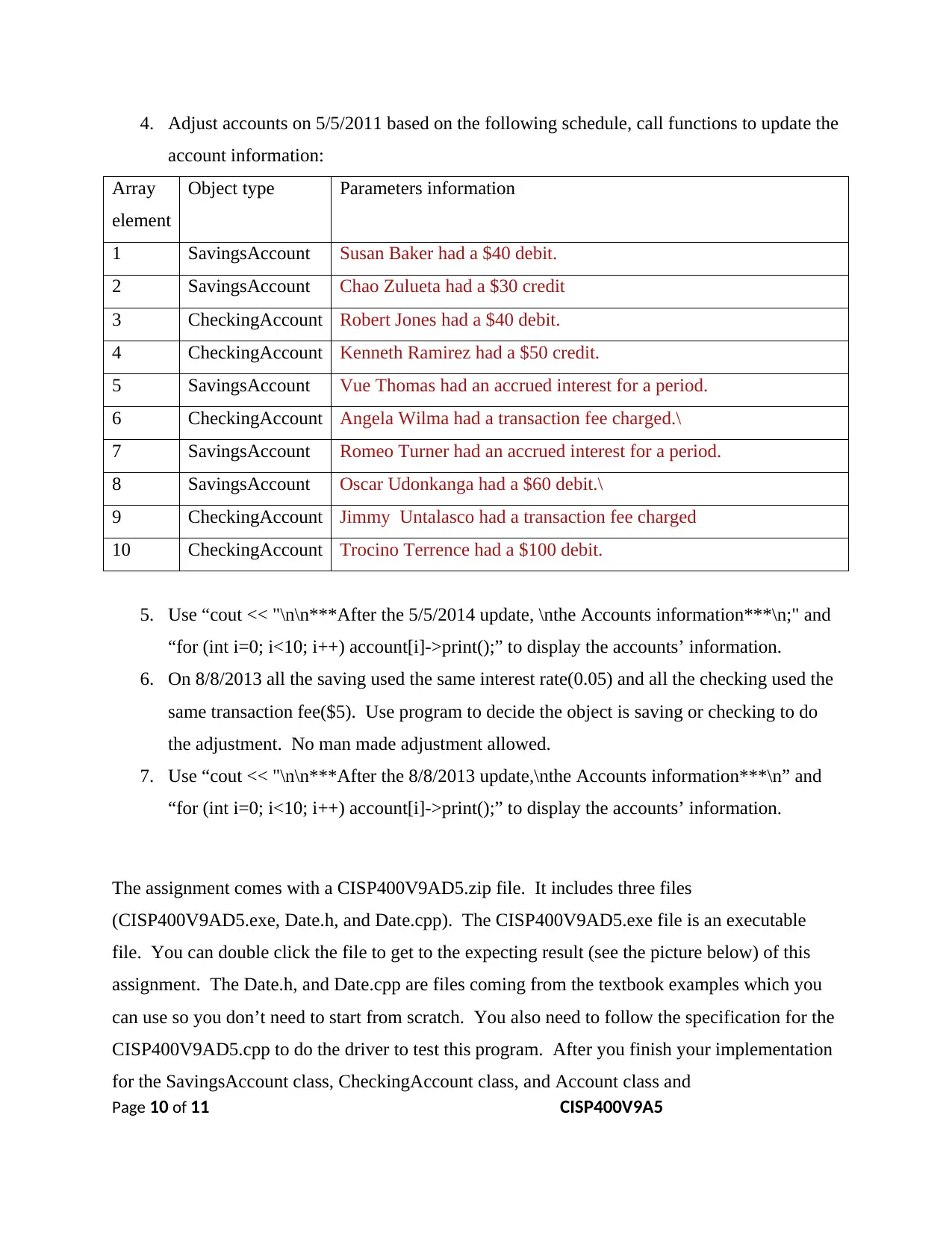
4. Adjust accounts on 5/5/2011 based on the following schedule, call functions to update the
account information:
Array
element
Object type Parameters information
1 SavingsAccount Susan Baker had a $40 debit.
2 SavingsAccount Chao Zulueta had a $30 credit
3 CheckingAccount Robert Jones had a $40 debit.
4 CheckingAccount Kenneth Ramirez had a $50 credit.
5 SavingsAccount Vue Thomas had an accrued interest for a period.
6 CheckingAccount Angela Wilma had a transaction fee charged.\
7 SavingsAccount Romeo Turner had an accrued interest for a period.
8 SavingsAccount Oscar Udonkanga had a $60 debit.\
9 CheckingAccount Jimmy Untalasco had a transaction fee charged
10 CheckingAccount Trocino Terrence had a $100 debit.
5. Use “cout << "\n\n***After the 5/5/2014 update, \nthe Accounts information***\n;" and
“for (int i=0; i<10; i++) account[i]->print();” to display the accounts’ information.
6. On 8/8/2013 all the saving used the same interest rate(0.05) and all the checking used the
same transaction fee($5). Use program to decide the object is saving or checking to do
the adjustment. No man made adjustment allowed.
7. Use “cout << "\n\n***After the 8/8/2013 update,\nthe Accounts information***\n” and
“for (int i=0; i<10; i++) account[i]->print();” to display the accounts’ information.
The assignment comes with a CISP400V9AD5.zip file. It includes three files
(CISP400V9AD5.exe, Date.h, and Date.cpp). The CISP400V9AD5.exe file is an executable
file. You can double click the file to get to the expecting result (see the picture below) of this
assignment. The Date.h, and Date.cpp are files coming from the textbook examples which you
can use so you don’t need to start from scratch. You also need to follow the specification for the
CISP400V9AD5.cpp to do the driver to test this program. After you finish your implementation
for the SavingsAccount class, CheckingAccount class, and Account class and
Page 10 of 11 CISP400V9A5
account information:
Array
element
Object type Parameters information
1 SavingsAccount Susan Baker had a $40 debit.
2 SavingsAccount Chao Zulueta had a $30 credit
3 CheckingAccount Robert Jones had a $40 debit.
4 CheckingAccount Kenneth Ramirez had a $50 credit.
5 SavingsAccount Vue Thomas had an accrued interest for a period.
6 CheckingAccount Angela Wilma had a transaction fee charged.\
7 SavingsAccount Romeo Turner had an accrued interest for a period.
8 SavingsAccount Oscar Udonkanga had a $60 debit.\
9 CheckingAccount Jimmy Untalasco had a transaction fee charged
10 CheckingAccount Trocino Terrence had a $100 debit.
5. Use “cout << "\n\n***After the 5/5/2014 update, \nthe Accounts information***\n;" and
“for (int i=0; i<10; i++) account[i]->print();” to display the accounts’ information.
6. On 8/8/2013 all the saving used the same interest rate(0.05) and all the checking used the
same transaction fee($5). Use program to decide the object is saving or checking to do
the adjustment. No man made adjustment allowed.
7. Use “cout << "\n\n***After the 8/8/2013 update,\nthe Accounts information***\n” and
“for (int i=0; i<10; i++) account[i]->print();” to display the accounts’ information.
The assignment comes with a CISP400V9AD5.zip file. It includes three files
(CISP400V9AD5.exe, Date.h, and Date.cpp). The CISP400V9AD5.exe file is an executable
file. You can double click the file to get to the expecting result (see the picture below) of this
assignment. The Date.h, and Date.cpp are files coming from the textbook examples which you
can use so you don’t need to start from scratch. You also need to follow the specification for the
CISP400V9AD5.cpp to do the driver to test this program. After you finish your implementation
for the SavingsAccount class, CheckingAccount class, and Account class and
Page 10 of 11 CISP400V9A5
Paraphrase This Document
Need a fresh take? Get an instant paraphrase of this document with our AI Paraphraser
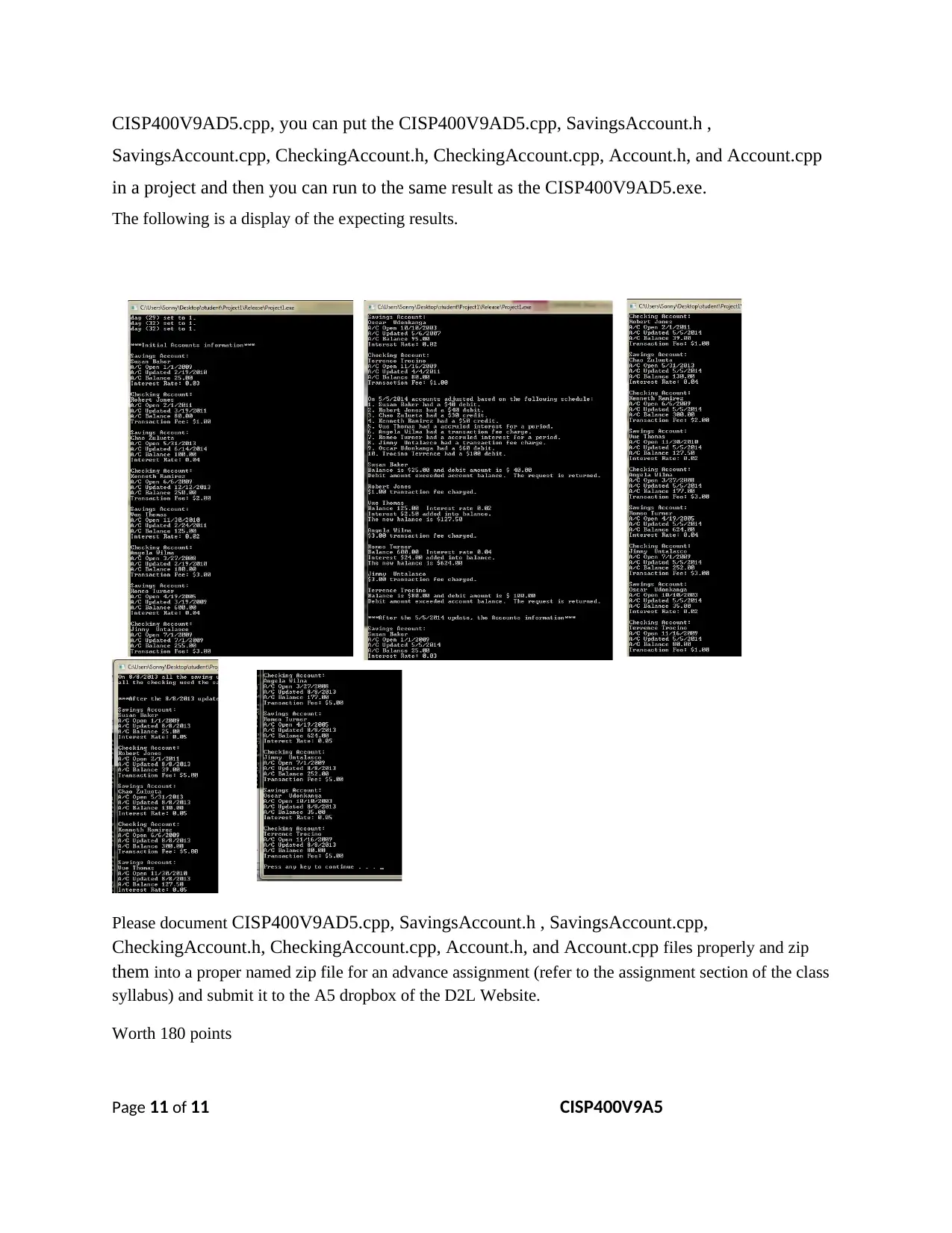
CISP400V9AD5.cpp, you can put the CISP400V9AD5.cpp, SavingsAccount.h ,
SavingsAccount.cpp, CheckingAccount.h, CheckingAccount.cpp, Account.h, and Account.cpp
in a project and then you can run to the same result as the CISP400V9AD5.exe.
The following is a display of the expecting results.
Please document CISP400V9AD5.cpp, SavingsAccount.h , SavingsAccount.cpp,
CheckingAccount.h, CheckingAccount.cpp, Account.h, and Account.cpp files properly and zip
them into a proper named zip file for an advance assignment (refer to the assignment section of the class
syllabus) and submit it to the A5 dropbox of the D2L Website.
Worth 180 points
Page 11 of 11 CISP400V9A5
SavingsAccount.cpp, CheckingAccount.h, CheckingAccount.cpp, Account.h, and Account.cpp
in a project and then you can run to the same result as the CISP400V9AD5.exe.
The following is a display of the expecting results.
Please document CISP400V9AD5.cpp, SavingsAccount.h , SavingsAccount.cpp,
CheckingAccount.h, CheckingAccount.cpp, Account.h, and Account.cpp files properly and zip
them into a proper named zip file for an advance assignment (refer to the assignment section of the class
syllabus) and submit it to the A5 dropbox of the D2L Website.
Worth 180 points
Page 11 of 11 CISP400V9A5
1 out of 11
Related Documents
Your All-in-One AI-Powered Toolkit for Academic Success.
+13062052269
info@desklib.com
Available 24*7 on WhatsApp / Email
![[object Object]](/_next/static/media/star-bottom.7253800d.svg)
Unlock your academic potential
Copyright © 2020–2025 A2Z Services. All Rights Reserved. Developed and managed by ZUCOL.




